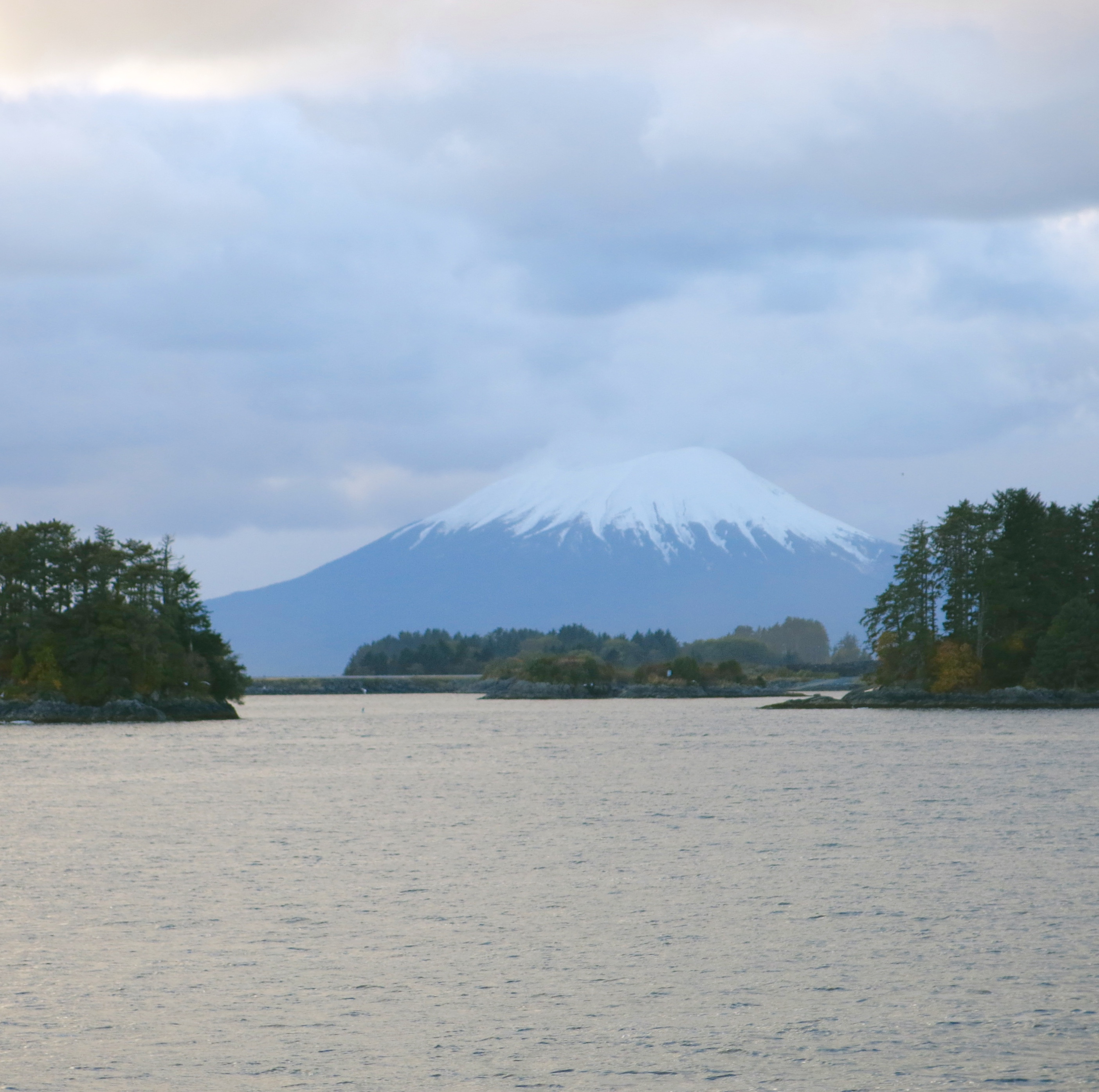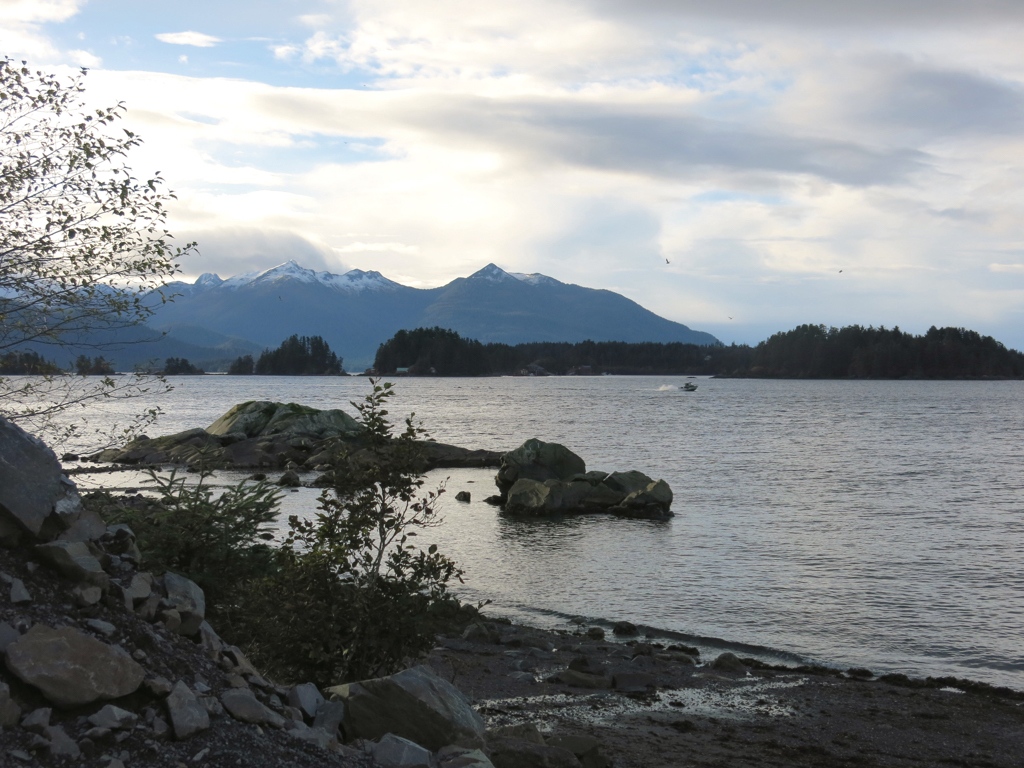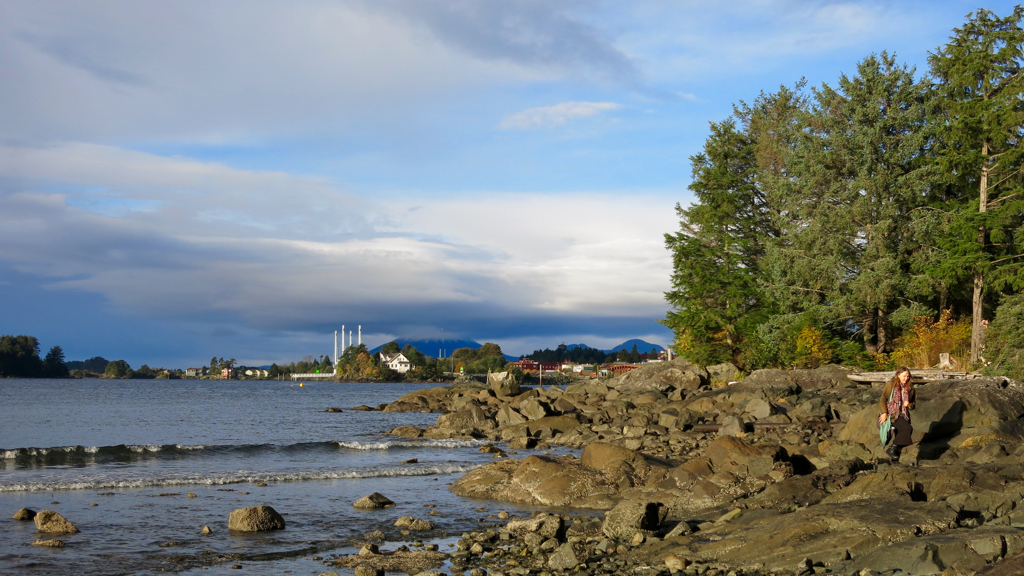Carol and I are here in Alaska to participate in the Alaska Sacred Harp Convention, and we have been singing every day, and we attended a “singing school,” pretty much as you’d expect. But our gracious host Kari also arranged for those attending the convention to go on a whale watch trip. Over the course of an hour and three quarters on the water, we saw more than twenty humpback whales — and the scenery was spectacular as well. I particularly enjoyed looking at Mt. Edgecumbe, a long-extinct volcano. At this season Mt. Edgecumbe is snow-clad from it summit about halfway down to the sea, making it look like something out of a classic Japanese woodblock print, only more dramatic.
Author: Daniel Harper
Fairy Barf
Sitka
Housing
We’re looking for a new place to live — our landlord is finally selling the duplex where we live, so he can use the money to enjoy his retirement. We’ve been looking for most of a month now, and it has not been easy. The average rent for an apartment around here is ridiculously high; the Bay Area has some of the highest housing costs in the U.S. In some cities in the Bay Area, you can make over $80,000 a year and still qualify for affordable housing options.
We refuse to spend more than a third of our combined gross income on rent, and we would prefer to spend only a quarter of our gross income. The apartments we can afford are either tiny, or shabby, or sometimes both tiny and shabby. To make matters worse, competition for these relatively affordable, tiny or shabby apartments is intense. All this combines to make our search for housing into an unpleasant task.
The ridiculously high cost of housing, and the shortage of affordable housing, are problems that will not be solved any time soon. Build more affordable housing? Recent news stories carried by Bay Area media outlets make it clear that demand will outpace supply of new affordable housing for the foreseeable future. Impose rent control? Most local rent control initiatives have failed, under intense pressure from the real estate lobby. Leave the Bay Area? That’s the answer for many people; several cities in Silicon Valley have lost population in the past few years. Live on the streets? The homeless population in the Bay Area continues to grow.
I don’t have any answers. But I do know that we here in Silicon Valley have a front row seat for watching the growth in income inequality.
Smoke
We were awakened Sunday night by the smell of smoke. We got up in the dark and tried to figure out where the smell was coming from. Maybe the neighbors left a fire burning in their fireplace overnight, and the slight breeze was blowing it into our house? When we got up on Monday morning, we read that thousands of acres were burning about 70 miles north of us; we had smelled the smoke from those fires.
The wind shifted yesterday and the air cleared, but today the smoke returned. It appeared to be an overcast day, but it was smoke, not clouds, blocking the sun. Over in the East Bay, Ms. M.’s spouse saw ash falling out of the sky in Oakland. I stayed indoors with the windows closed.
In the afternoon, Carol found an apartment for us to look at over in Half Moon Bay. We drove up Highway 92 into the hills west of San Mateo. The smoke reduced visibility so that from the flats where we started out, the tops of the hills looked blue and misty.
< 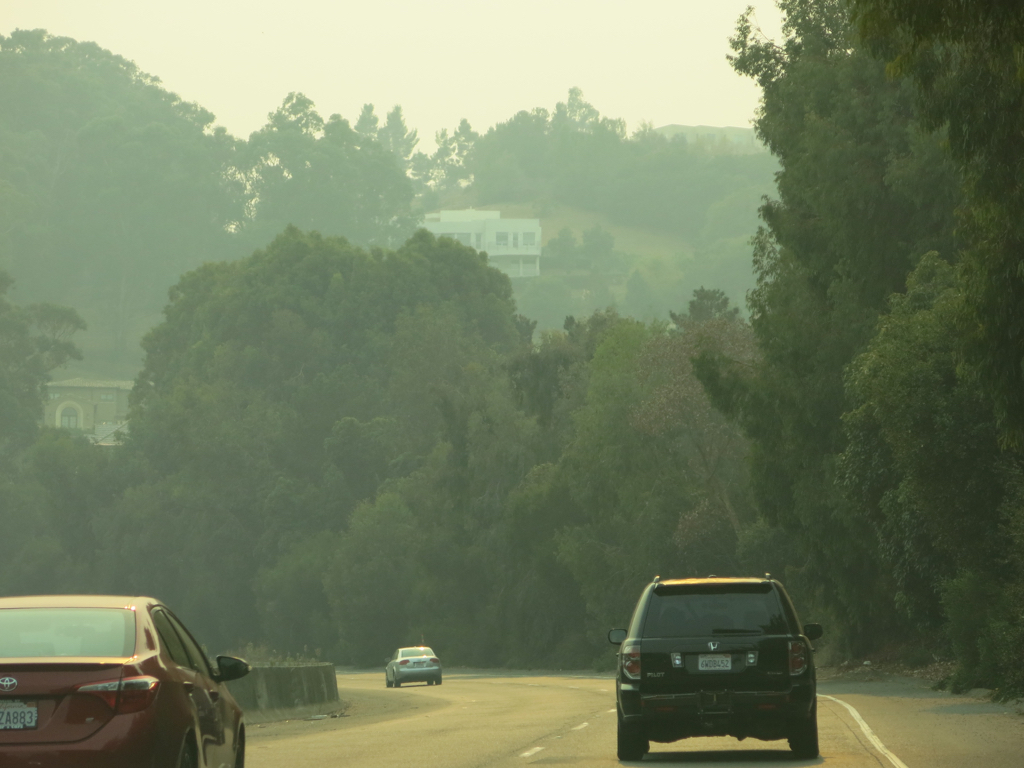
In Half Moon Bay the air smelled clean; the line of hills to the east, and an onshore breeze, kept the smoke away. But we could see the smoke above us, a wide plume about a thousand feet up. As the sun got low in the sky, the plume of smoke turned it into a lurid red glowing ball, like a huge red traffic light in the sky.
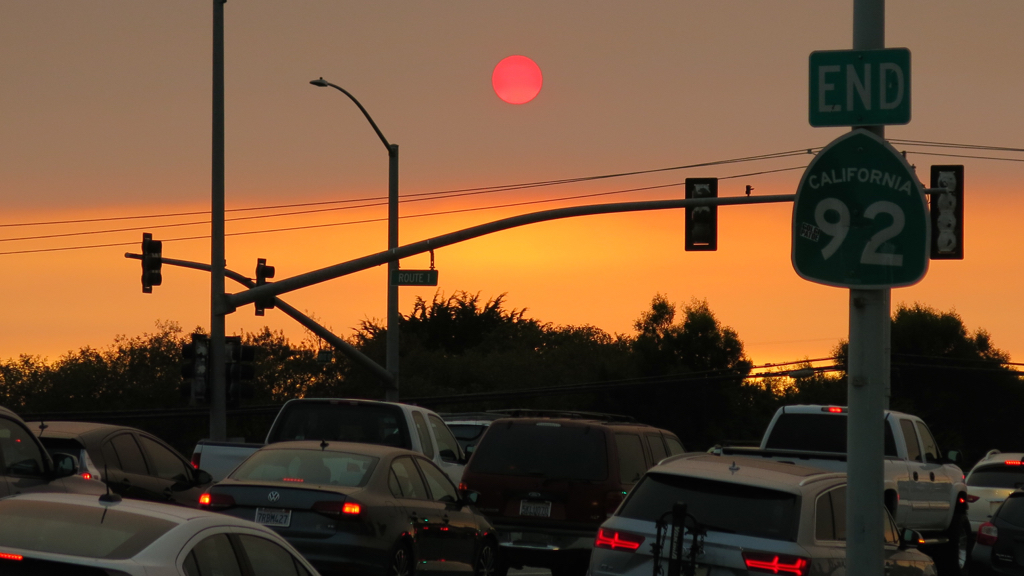
In addition to global climate change…
In the United States, there’s this stereotype that different human populations worry about different environmental catastrophes. College-educated white suburbanites, so the stereotype goes, worry more about global climate change — perhaps because they are more aware of how much energy it takes to power their many automobiles, and to heat their large homes. Communities of color and working class whites, so it is said, worry more about toxics in the environment — perhaps because people of color and working class people are more likely to be exposed to more toxic substances in the places they live and work.
College-educated white people have tended to be dismissive of the threat of toxics in the environment, at least in comparison to the threat of global climate change. Global climate change has the potential to cause another “great extinction” and to decrease human chances of survival, whereas toxics in the environment don’t have the potential to do as much damage.
But I think we all should start worrying more about toxics in the environment.
According to a BBC article titled “Pesticides linked to bee deaths found in most honey samples,” a recent study published in Science shows that neonicotinoids have been found in three quarters of honey samples from around the world (from every continent except Antarctica). The widespread presence of neonicotinoids is especially troubling, because they were found in places where the chemicals have been banned for several years.
When asked by the BBC to comment on the article, Dave Goulson, professor of biology at the University of Sussex, said: “Entire landscapes all over the world are now permeated with highly potent neurotoxins, undoubtedly contributing to the global collapse of biodiversity.”
The collapse of biodiversity is bad enough. But consider, too, that if we humans kill off major pollinators, there’s a potential cascade effect that could drive many flowering plants towards extinction. So if you’re looking for a cause of the next “great extinction,” or if you’re just looking for another reason to lie awake at night and worry — look no farther than toxics in the environment.
Basic classroom management for Sunday schools
At today’s “Pot of Gold” religious education conference, I led a session called “Teaching 101” in which I went over some of the basics of teaching for Sunday school teachers. Below is my handout on classroom management — a PDF version, and a text version (the PDF version has some additional material):
PDF version of “Classroom Management: Some Ideas to Help You Mange
CLASSROOM MANAGEMENT: SOME IDEAS TO HELP YOU MANAGE (text only)
The basics
These are the simplest things to do to help minimize behavior problems:
(1) Make sure each child or teen is noticed and is heard. This is one purpose of the opening check-in: everyone says their name, and tells a little bit about themselves. Especially when new to a class, a young person needs to feel that they are noticed, that their voice can be heard, and that they belong. This can reduce acting-out behaviors.
(2) Help children or teens learn names of everyone in class. This is a long-term goal; at the beginning they should at least hear the names of everyone in the class during check-in. Everyone will feel more secure, and be better behaved, when they know at least barest minimum—the names—of all the adults and children/teens in the class.
(3) Be clear about the purpose of the class. It can help if everyone is reminded why they are in the class. If there’s a stated purpose, most children/teens will buy into it. When you must reprimand someone, it can help to remind them of the purpose of the class so they understand why they are being reprimanded.
(4) Be clear about the values of the class. In a UU Sunday school, we value behavior that shows we care for one another. Regular opening words (“We light this chalice…”) or a quick statement of purpose (“Here we are again to learn about human sexuality”) help remind everyone of these basic values.
More practices towards a well-managed classroom
(A) When preparing for the class, run a video in your head of how it will go. As you go over each activity, you imagine how each child or teen will respond to that activity. If an activity is very active and you know that T—— does not like to be very active, how will you involve that child/teen? If an activity requires sitting still and B—— has ADHD, how will keep that child/teen involved in the activity? Using this technique of running a video in your head as you prepare helps you build a mental model of the individuals, and of the class as a whole.
(B) Keep the educational goals and objectives in mind. Class sessions rarely go exactly as planned (one reason why teaching is so challenging and interesting). And kids often melt down when they sense that you, the teacher, have lost your direction. But if you keep in mind the educational goals (the big picture stuff) and the educational objectives (measurable things you want to accomplish in this class), you will find it easier to respond to classroom challenges. Thus when a class doesn’t respond well to a given activity, you can adapt it to their needs while still meeting your educational goals and objectives.
(C) Go from pre-assessment to teaching to assessment. “Pre-assessment” means finding out what the children or teens know before you begin teaching; in RE this probably won’t be a written test; it might be asking the children/teens what they know about topic X. “Assessment” means finding out what the children or teens have learned in the class session; again, in RE this probably won’t be a written test; it might take the form of asking the children/teens to state one thing they have learned during the closing circle. Pre-assessment and assessment can also take place just before or after a given activity.
Why does this help with classroom management? If you’re teaching a lesson about something the kids already know well, you’re likely to face behavior problems—some simple pre-assessment would let you know how to tweak your lesson plan to meet the needs of the students. Conversely, if your lesson is way above the level of the kids, you’re going to lose them, which can lead to unpleasant behaviors; again, some pre-assessment would help you to tweak the lesson so you don’t lose the kids. And some very simple assessment at the end of the class — asking each young person to say one thing they learned today, or one thing they’re taking away from the class — can help the participants see that the class had purpose and a positive outcome.
(D) Use class rituals. Children and teens will be more relaxed and comfortable when there are consistent class rituals that are followed. A suggested minimum for classroom ritual: 1. An opening ritual with names, check-in, and a restatement of the class purpose. 2. A closing circle where you review with the children/teens what they have learned.
A rabbi in hurricane land
Abs sent me a link to a Washington Post article about Rabbi Michael Feshbach, an old college friend of mine who is the new rabbi at the Hebrew Congregation of St. Thomas, U.S. Virgin Islands. Yes, St. Thomas, one of the islands hit by two Category Five hurricanes this month.
The Post article was written before Hurricane Irma hit, and the good news is that Mike has posted on Facebook that he and his family made it through Irma safely. Not only that, but the congregation’s Torah scrolls came through both storms with minimal damage. A curfew has been imposed on St. Thomas, so they’re having to adjust the times of their services; but at least they can hold services.
Rabbi Michael offered one of the best progressive theological readings of these two disastrous hurricanes in the Post article. Asked by the reporter what the meaning of the hurricanes was, he gave a thoughtful response:
“‘I come from a progressive religious tradition that takes spirituality and God seriously but not necessarily always in traditional ways,’ Rabbi Feshbach said. ‘I do not think that things happen for a reason, as sacrilegious as that may sound.’ God, Rabbi Feshbach said, doesn’t control the weather. God doesn’t direct some of us onto a plane doomed to crash and others into a traffic jam that keeps us from boarding that plane. ‘That’s not a God I can live with,’ he said. For Rabbi Feshbach, God is there for how we react to tragedy and how we help each other get through it.”
I concur with all my heart. And if Unitarian Universalists in the Bay Area of California can react by helping in any way, all Rabbi Feshbach and his congregation have to do is ask.
A minor deity
Here’s a small figure, probably a deity, from the Ifugao people of the Philippines. This figure sits on top of a small container used for holding agriculatural lime (a misture consisting primarily of calcium carbonate), one of the constituents used in preparing a mild stimulant from betel leaf (Piper betle) and the nut of the areca palm (Areca catechu).
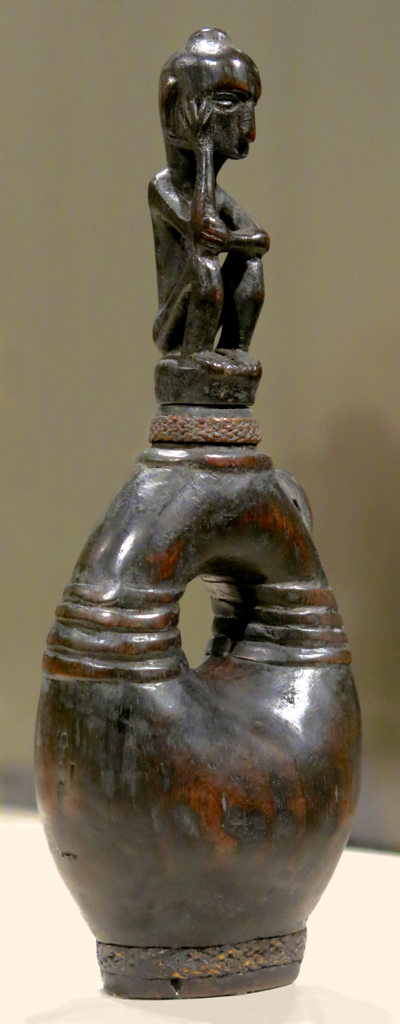
This figure, made sometime in the first half of the twentieth century, is probably an ancestor deity, or a guardian deity — akin, perhaps, to the household gods of Rome, minor deities which have retained a place in the collective memory of the Western tradition.
In the West, we tend to assume that a deity by definition is unitary (or unitary-but-triune), and transcendent. We forget that for much of human history, there were a multiplicity of deities that lived quite close at hand; and we forget that a significant percentage of humans today still live in a world where many deities live close at hand. And perhaps these close-at-hand deities have never really left our collective consciousness; today we keep our glowing smartphones always with us, just as the ancient Romans kept the statues of their Lares or household gods close at hand so that they might consult them constantly, to ensure good fortune.
An Asian Mary
On a recent visit to the Asian Art Museum, I saw a beautiful mixed media sculpture of the Virgin Mary. The body of the sculpture was made of wood, the head and hands of ivory, a crown of stars of metal, and the hair of actual human hair.

When Westerners think of Asian religious art, they tend to think of Buddhas and Ganeshas and Guan Yins, forgetting that Christianity has had a presence in Asia for more than 1900 years. So of course there are Asian Christs and Asian Marys.
This Virgin Mary was made in the Philippines, to whence Christianity was brought by European Christians about five hundred years ago. The sculpture cannot be precisely dated, but was made sometime between 1650 and 1800.
Anyone familiar with European Christian art from the Middle Ages and the Renaissance will recognize the iconography of Mary standing on a crescent moon. But some of the details feel Asian. Mary’s facial features do not look stereotypically European, and according to the wall label next to the sculpture, “Early Spanish reports describe artists of Chinese descent as well as Filipino artists carving these images in the Philippines.” The treatment of the draped fabric feels non-European to me, especially Mary’s blue robe, which takes on a life of its own in a way that European Renaissance sculptures, based on classical models, never do; it feels more like the flowing, moving fabric found on some Chinese sculptures, or even on some Medieval European sculptures. I particularly like the use of human hair, a material that anchors Mary in the human realm, and keeps her from drifting into a realm of inaccessible transcendence.
In short, here is a deity that incorporates European iconography with Asian forms and sculptural traditions; she is a globalized deity who also links the human to the transcendent realms.

